"Ink and Light" defines my abstract photo images.
They begin as light and become manifest in ink. They are made
in-camera, each chosen from tens of hundreds of images from a shoot, and
processed in cutting edge digital darkroom programs. They are
drawings and paintings made with a camera. I push and pull light,
grab onto specular highlights, and paint by manipulating the camera
manually, shaping the essence of light until finally, the images are
realized in ink. Ink and light, on paper, canvas, and metal, the
images appear from another world, unseen, but oddly familiar.
Simply put, my abstract photos are "motion blur"
photographs, akin to the photographic technique called "panning".
We've all seen "panning" shots of race cars where the car
is in focus and the background is blurry. This effect is achieved by
focusing on the subject and tracking or following the subject. The
result is most often a blurred background which can be uniquely
expressive.
I use the technique of panning and push it to its
boundaries. When I began serious enquiries into the motion blur
effect for making abstract photos, I experimented with panning shots in
downtown Vancouver in 2005. The following image, titled Step Into
The Light, illustrates a motion blur panning shot.
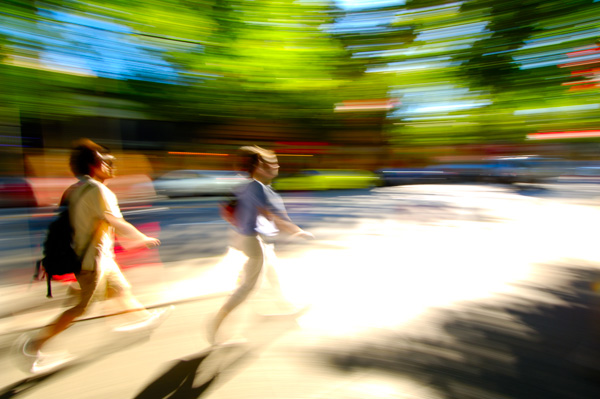
Mark Lindquist, Step Into The Light, (From
the Light-Walkers Series), 2005, Vancouver, BC, Nikon D2H
Copyright 2005, Lindquist Studios
BREAKING THROUGH TO THE OTHER SIDE
As I gain control over the process that creates my
abstract photographs (what I call "Robography"), I am looking for pathways
of expression that are uniquely my own yet are informed by traditional
photographic techniques and historical approaches.
While working in the field of woodturning, when I applied robotic
processes to certain aspects of work holding and object making, I began to
understand the concept of that which is seemingly unattainable: the
glimpse that is given inspires confidence to continue through many years
of pursuit. It occurs to me now, after over forty years of making machines
to create sculpture and making sculptures themselves, that the idea exists
"over there."
Now, for me, when shooting with a camera, creating a Robograph (Robograf,
Robograv -- abstract photograph made using my evolved motion blur
process), the conditions must be exactly right. The light must be perfect,
the camera must be perfect, the setup must be perfect, the mood must be
perfect, the approach must be relaxed, while ultimately done with fervor.
The light goes away. The time to set up marches on inconsolably, the
process involves setbacks. Hopefully there is another late afternoon light
that will reveal the same effect, but it is not always the case. The
balance between work and play is critical. The approach is that of the
scientist, the experimenter, but also the songwriter or poet.

Mark Lindquist, Antelope Dream,
2005, Nikon D2H, copyright Lindquist Studios
I have often thought about Chuck Yeager and the team that set about to
break the sound barrier. Each time they approached the sound barrier the
plane shook violently almost to the point of breaking apart. Finally,
Yeager broke through to the other side and the flight smoothed out. Each
time, going to break the barrier anew, the same thing happened: like that,
with a bang, they were on the other side. So I think about my
Robographical process, similarly: it requires the effort to get there,
then to break on through to the other side. If it doesn't get to the other
side, (when critical elements are either missing or not in concert), then
the result is less than stellar. I would call it a kind of mediocrity at
its more elevated level. When the image comes back from the other side, it
is a new creation of what does not exist in our world as we know
it. Shapes shift, colors meld, and form and line bend and warp in other
world timeliness. If not in that other realm, objects are still extant,
tentatively recognizable, and it spoils the illusion.
Knowing what the object is (or was) is not what the newly
recreated image from the other side is about. To know what the image came
from is largely doom -- it crashes violently back to our world of reality
when it was originally headed for the dream world. Sometimes it requires
Herculean effort to push through to capture that most fleeting of images,
the right one may be the only one out of gigabytes and gigabytes of
attempts over days, weeks, months. But sometimes, once broken through,
there is beautifully smooth sailing and every image is amazingly,
hauntingly perfect. presenting an even greater challenge to edit down,
edit down, to distill.
There are easy ways to capture abstract images through
night photography of neon lights or car lights moving down the road. This
is a known, almost automatic technique that results in glowing lines on a
black background. I am interested in pushing, moving, shaping light in any
time, through control. I strive to master control of the process that I
formerly deemed serendipitous (happy accident). In each aspect of
shooting, it was always dogged determination and stubbornness that got me
the shot I was after -- that elusive prize on the other side. Gradually,
pushing to learn more and more about technical aspects of capturing and
processing, using specialized tools and techniques, things begin to come
together in a more controlled environment where light begins to move for
me the way I am accustomed to moving wood or paint, or steel.
So much of photography is about revealing the unknown. We
can see the eye of the eagle that is so high above using a 600 mm lens.
But I can see the image of my dreams (mind's eye) using robomimical
process and devices. Applying the studied and careful practice of the
potter, methodically wading through mounds of clay, at the end of the day
I have many images to be "trimmed and glazed." When I apprenticed to a
potter, he taught me to destroy all pots except those that achieved the
ideal we were trying to express. So it is, then, after firing, only a few
will remain....
RECURSIONS: The Various Forms
My abstract images consist of various types:
1) Single in-camera images (one image chosen from gigabytes of shots
taken during one or more shooting sessions - normally outdoors in the late
afternoon light)

Mark Lindquist, JetStreamline,
copyright Lindquist Studios
2) Mirror images, where the original single shot is flipped horizontally
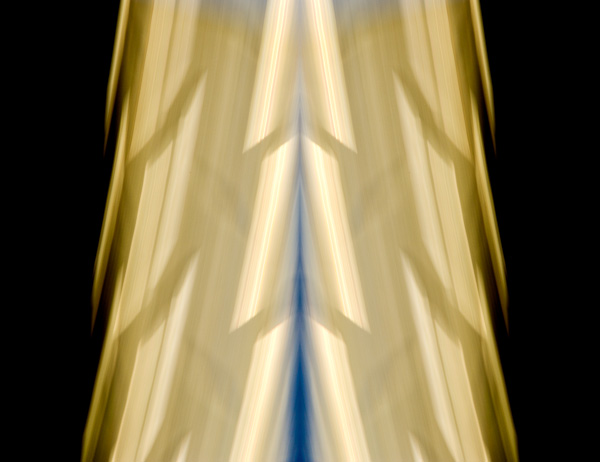
Mark Lindquist, Chrysler,
copyright Lindquist Studios
3) Mirrored and manipulated images, where the image is flipped both
horizontally and vertically, and rotated and cropped to create a final
abstract form.

Mark Lindquist, Conga,
copyright Lindquist Studios
4) Mirrored and manipulated images, where the image is flipped both
horizontally and vertically, and rotated and cropped, flipped back upon
itself, cropped back, rotated and further manipulated in puzzle-like
convolutions, where the image is complete when, based on the outcome, I
determine it is time to stop, which is simply an aesthetic decision.
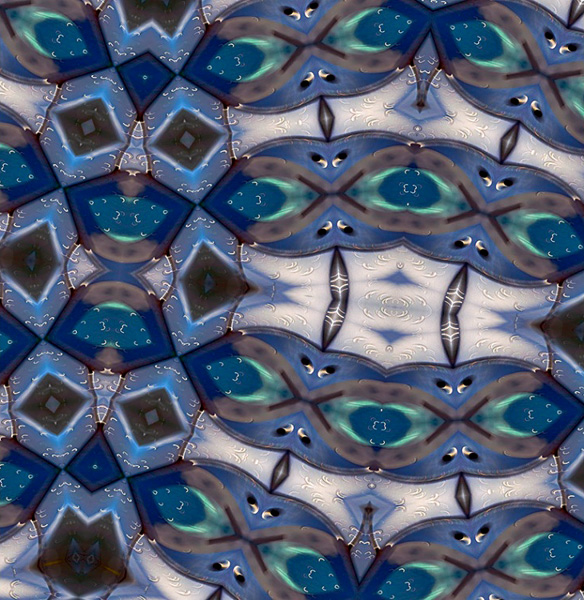
Mark Lindquist, Oceana/Africana,
copyright Lindquist Studios
TITLES: How and why they are named
Usually, I have a concept in mind as I develop a finished photograph from
the initial image. I am trying to evoke the spirit of a place and time as
in a dream, not to produce an image that directly refers to a specific
object. My titles are intended to suggest those concepts without insisting
on them; as abstractions, the photographs are open to the interpretation
of the viewer. Often the titles refer to dream-like objects; they are
surreal images that mirror a parallel artistic universe.
In Big Night at the Bijou, (below) the image
conjures up the late night neon lights and marquee of a movie theatre in
an earlier time, when theatres added glamour and excitement to small towns
across the country.
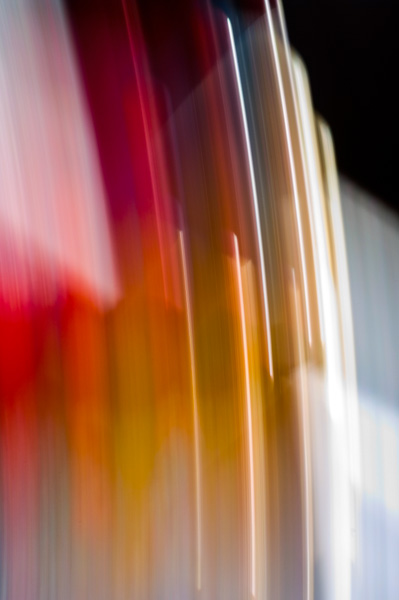
Mark Lindquist, Big Night at the Bijou,
copyright Lindquist Studios
Astoria (below) takes its name from a mind's eye view of a
non-existent ceiling of a dream-like, imaginary Waldorf Astoria.
Somehow, looking up into the vaulted ceiling creates perspective and
invites entry into the image.
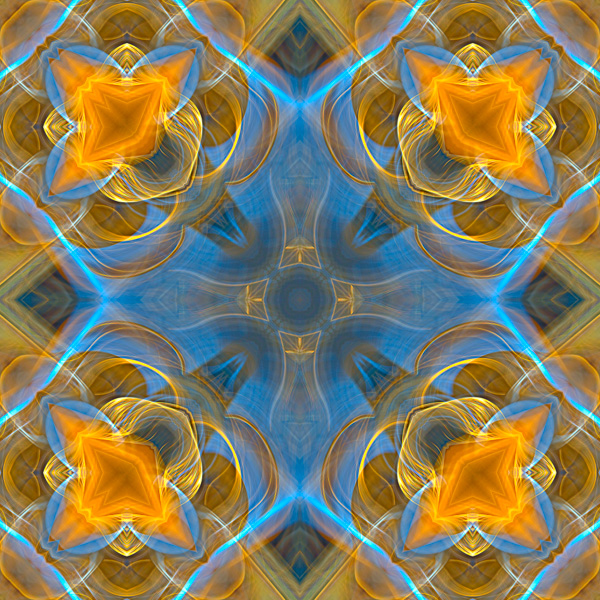
Mark Lindquist, Astoria,
copyright Lindquist Studios